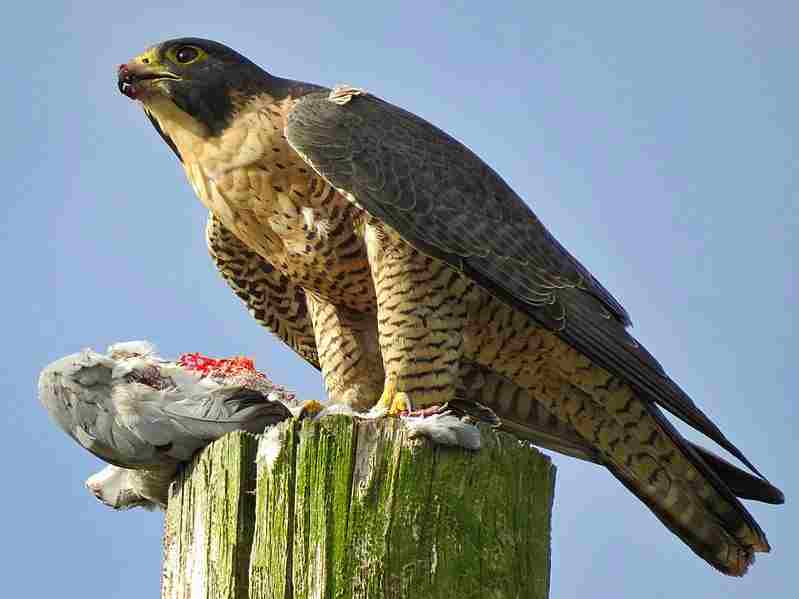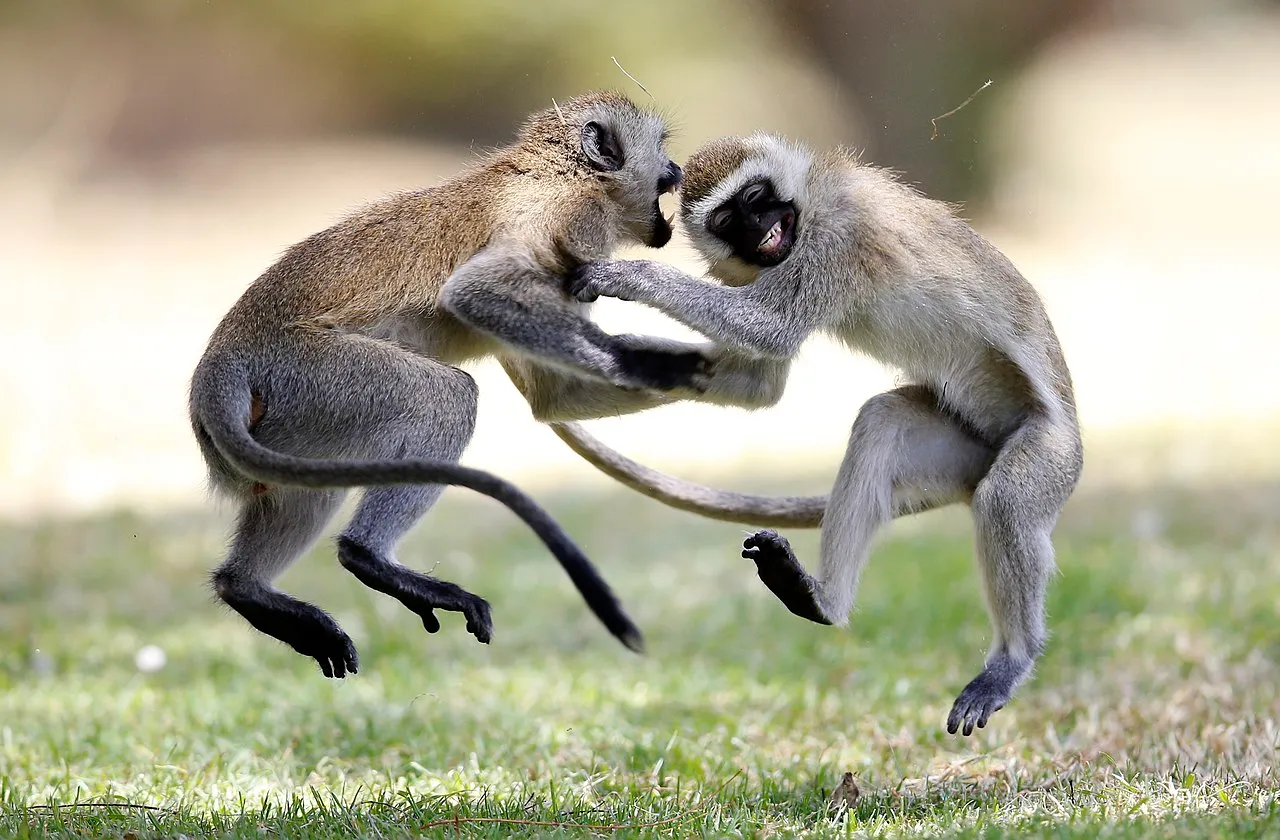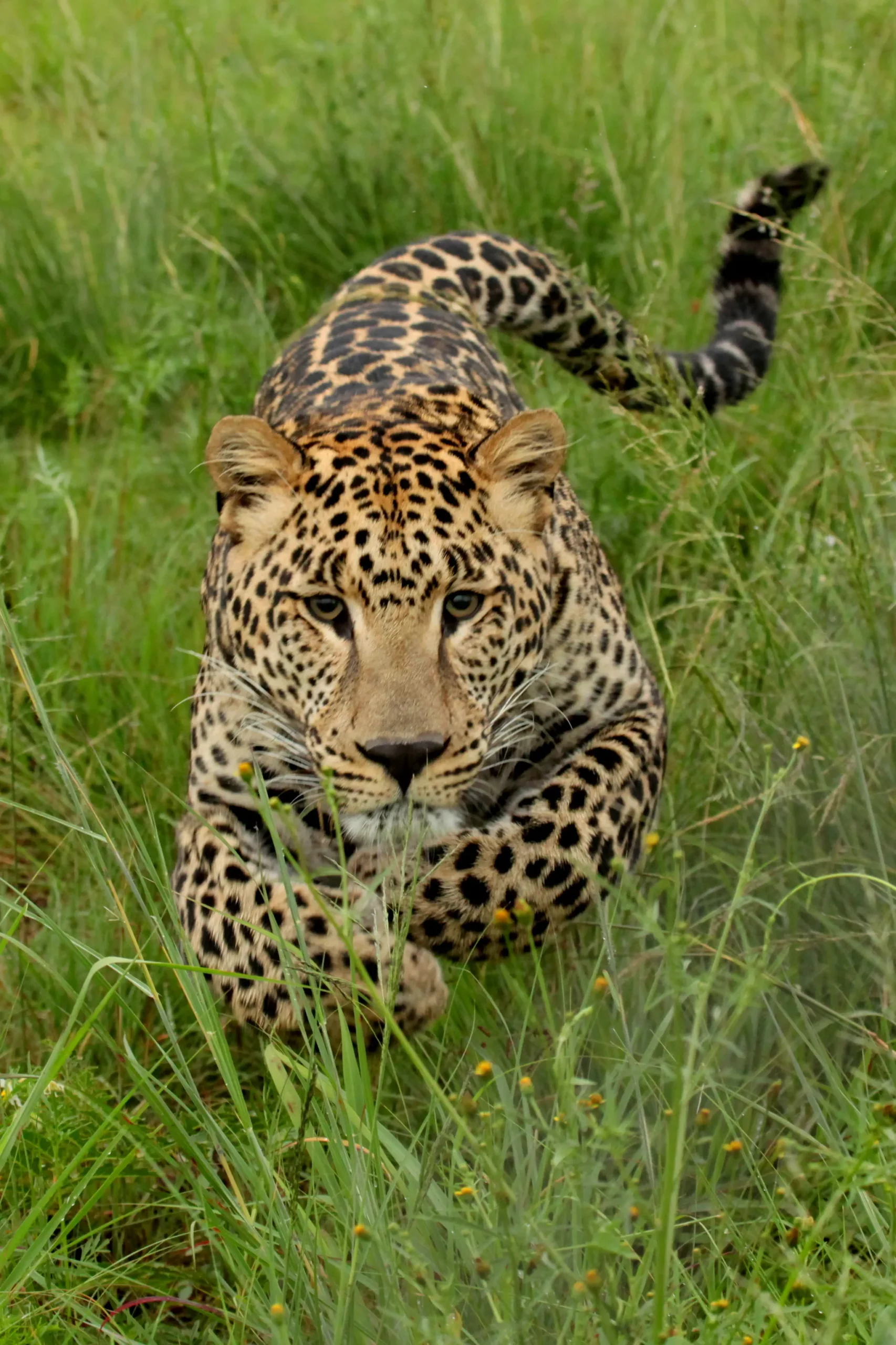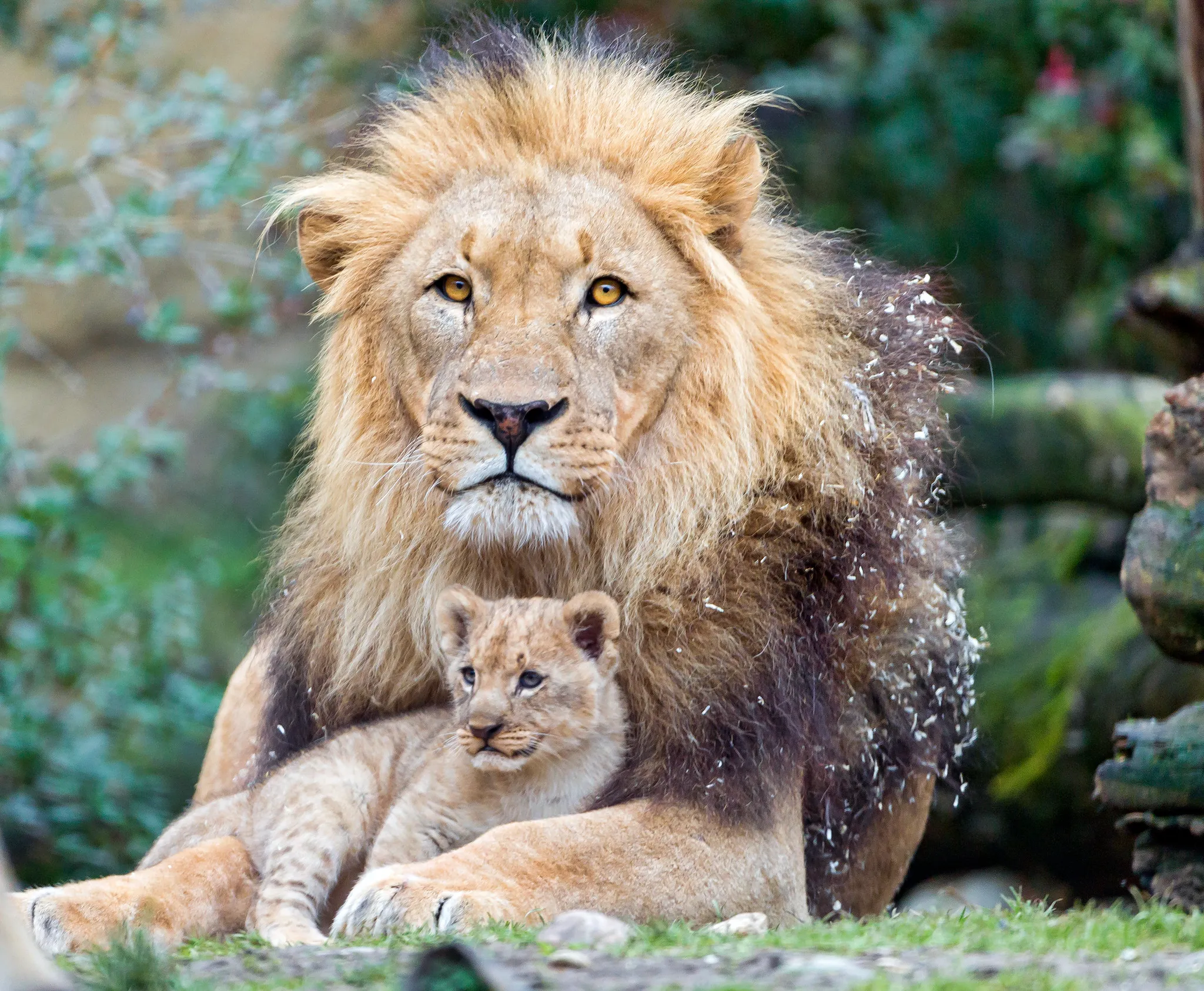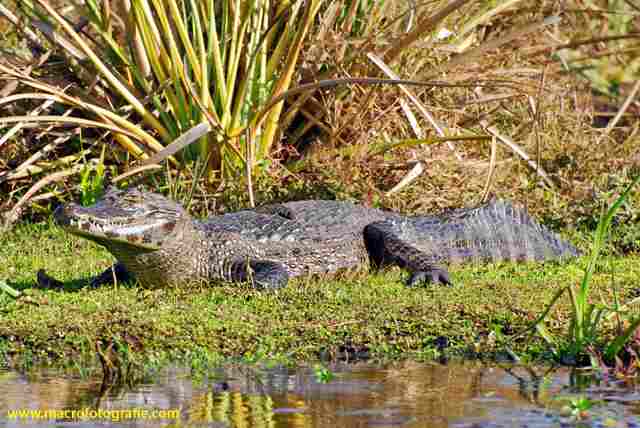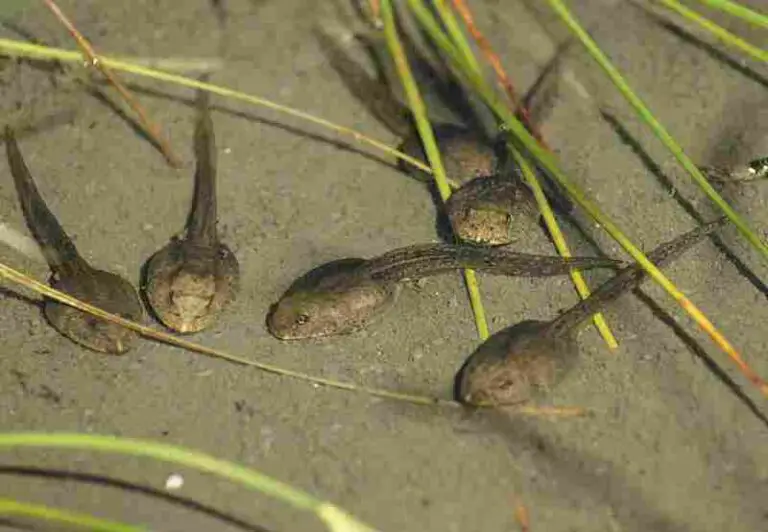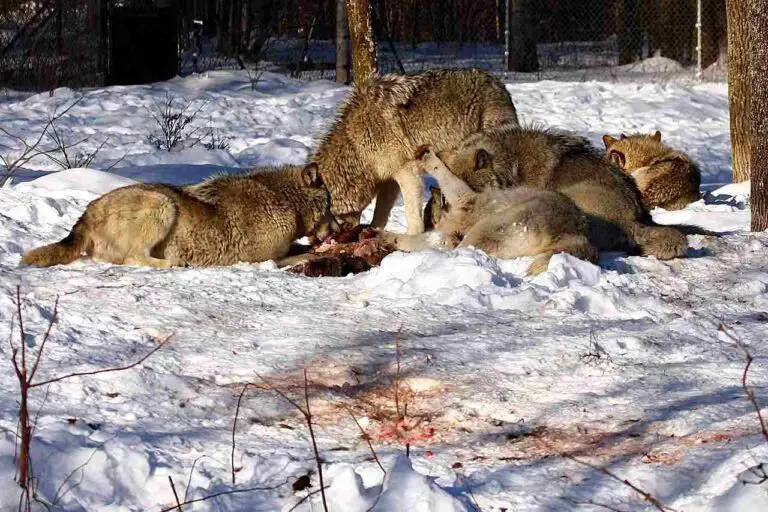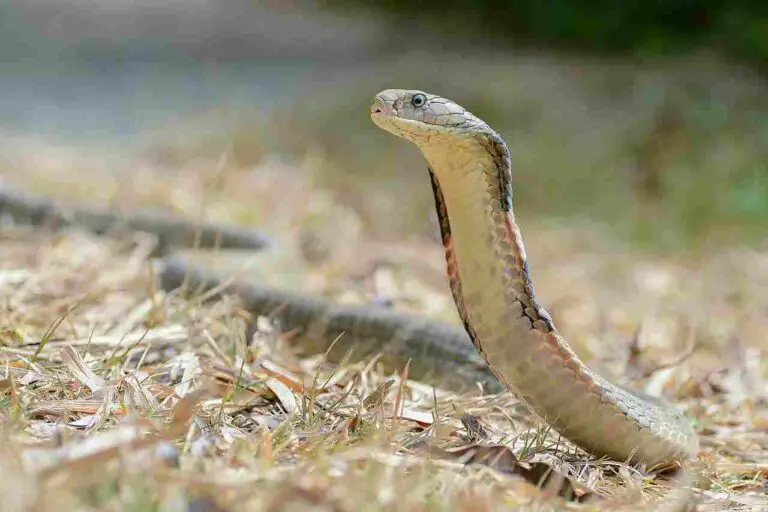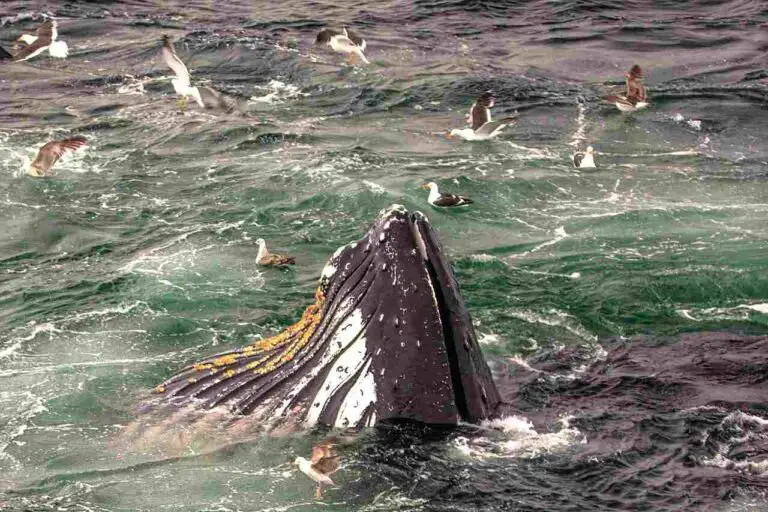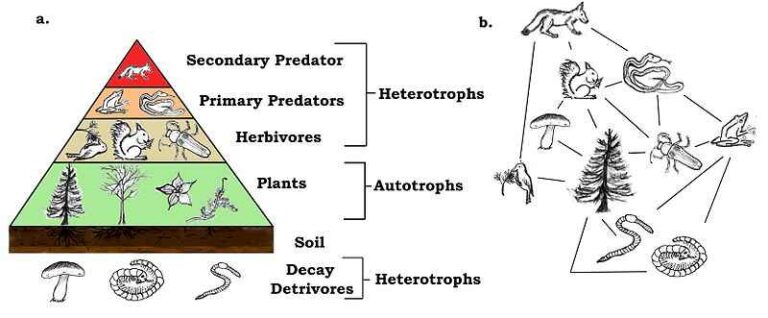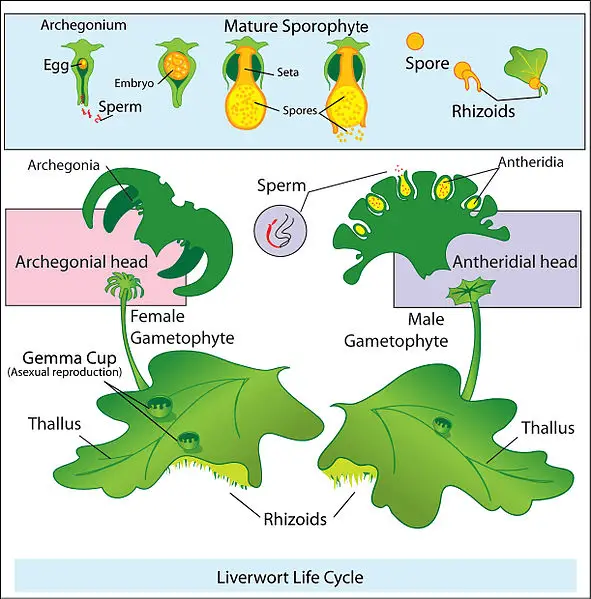Congo Rainforest Food Chain | Congo Rainforest Food Web
Congo Rainforest food chain is made up of producers like iroko, primary consumers like African pygmy squirrel, secondary consumers like Eastern chimpanzee, tertiary consumers like Congo Bay owl, and quaternary consumers like the African crowned eagle.
Congo Rainforest food web is a complex trophic network of energy-based relationships that control the consumption and regeneration of forest biotic resources. It can be resolved into a series of linear sequences (chains) for studying the details of trophic interconnectivity in the tropical rainforest.
This article discusses the Congo Rainforest food chain and food web respectively, as outlined below;
-Congo Rainforest Food Chain
1). Producers in the Congo Rainforest Food Chain
Producers in the Congo Rainforest are organisms that can photosynthesize or use other methods to convert light from the sun (that is; solar radiation) into chemical bioenergy, thereby creating the trophic foundation of the ecosystem.
They have a critical role which they play within the rainforest, by providing food (biomass), oxygen, and numerous resources that are essential to both wildlife and the economy. This section discusses some examples of producers in the Congo Rainforest, in terns of their functions and economic importance.
Examples of Producers in the Congo Rainforest, Their Functions and Economic Importance
Examples of producers in the Congo Rainforest are; Iroko, ebony, strangler fig, African Mahogany, raffia, and cinchona tree. They are discussed individually as follows;
1. Iroko (Milicia excelsa)
The Iroko is a large hardwood tree that is vital to the rainforest ecosystem. It produces seeds and fruits that serve as food for a variety of wildlife, and it contributes to the process of seed dispersal.
In the area of economic importance, Iroko is highly valued in the timber industry due to its durable and termite-resistant wood. It is used for various purposes, including furniture, construction, and boat building.
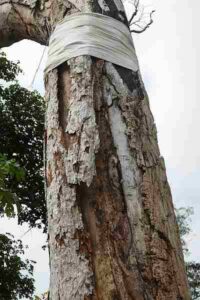
2. Ebony (Diospyros spp.)
Ebony trees are also important plants in the Congo Rainforest. They produce small, dark, and dense wood, play an effective role in seed dispersal, and provide both shelter and edible biomass for various wildlife.
Ebony is economically valuable, being highly sought after in the timber industry due to its beautiful and durable wood, which is often used in fine woodworking, musical instruments, and decorative art.
3. Strangler Fig (Ficus spp.)
Strangler figs are epiphytic plants that begin their life by germinating in the canopy of other trees. They eventually send roots down to the forest floor, progressively encircling and often smothering their host tree (whose place they subsequently take). They serve as a viable food source for some rainforest animals.
While not directly valuable in the timber industry, strangler figs contribute to the forest's species richness/biodiversity and offer foraging and growth opportunities for other organisms.
4. African Mahogany (Khaya spp.)
African mahogany trees are known to produce large, woody capsules that contain seeds. These seeds are a food source for birds, rodents, and insects.
Economically, African mahogany is a valuable timber species. Its wood is used in furniture making, construction, and other areas of woodcraft.
5. Raffia (Raphia spp.)
Raffia palms produce large palm fronds and clusters of small, coconut-like fruits. The fronds may serve as building materials and are also used for local craft, including the making of baskets, hats, and ropes.
Economically, raffia palms are important for their versatile and durable fronds, which are used in traditional crafts and can be a source of income for local communities.
6). Cinchona Tree (Cinchona spp.)
Cinchona trees produce quinine, which is a bitter compound found in the bark, that can be used for medicinal purposes and is effective in treating malaria.
This implies that cinchona trees are economically important for their bark, which is harvested for quinine extraction, and plays an effective role in combating malaria.
Generally, producers in the Congo Rainforest provide a multitude of ecosystem services, which include carbon sequestration, habitat engineering, and oxygen cycling/production.
In addition, the economic value of these plant species contributes significantly to local and global economies, which makes them essential resources for sustainable development and biodiversity conservation.
2). Primary Consumers in the Congo Rainforest Food Chain
Primary consumers in the Congo Rainforest have a vital role in the ecosystem, which entails feeding on plant material and serving as a food source for secondary consumers and other higher organisms. Here, some examples of primary consumers in the Congo Rainforest, and their basic functions, are discussed.
Examples of Primary Consumers in the Congo Rainforest and Their Basic Functions
Some examples of primary consumers in the Congo Rainforest are; African forest buffalo, African forest elephant, mouse deer, okapi, bonobo, locust, and some herbivorous ant species. Below is a concise discussion of these organisms/categories respectively;
1. African Forest Buffalo (Syncerus caffer nanus)
The herbivorous African forest buffalo is a large ungulate that primarily feeds on grasses and forbs found in the rainforest clearings. It contributes to seed dispersal and modification of the plant community.
2. African Forest Elephant (Loxodonta cyclotis)
These gentle giants are also herbivores, consuming a variety of leaves, fruit, and plants, helping to shape the forest structure through their browsing habits.
3. Mouse Deer (Tragulus spp.)
These relatively small herbivores feed on a variety of plant materials, such as leaves, fruits, and buds, thereby contributing to seed dispersal and plant regeneration/growth.
4. Okapi (Okapia johnstoni)
Okapi are primarily browsers, which feed on leaves, fruits, and fungi, and help to regulate the understory vegetation in the rainforest.
5. Bonobo (Pan paniscus)
While bonobos are omnivores and eat some animal matter, they are classified here as primary consumers because they also consume a significant amount of fruit, leaves, and plant material, also fostering seed dispersal and plant growth.
6. Locust (Orthoptera spp.)
These herbivorous insects feed on a wide range of plant materials, including leaves, stems, and seeds, which can affect plant health and regeneration.
7. Plant-Consuming Ant Species
Numerous ant species can be considered primary consumers as they feed on plant sap, nectar, and other plant-based resources. Ants are also instrumental in seed dispersal and soil conservation (through humification and aeration).
The primary consumers discussed here are all vital in the rainforest food web, as they transform plant material into energy that sustains the entire ecosystem. They also have ecological impacts on the structure and composition of plant communities in the Congo Rainforest.
3). Secondary Consumers in the Congo Rainforest Food Chain
Secondary consumers in the Congo Rainforest are organisms that mainly feed on primary consumers. Through the mechanism of active predation, these organisms play a definitive role in regulating the population of primary consumers.
They contribute to energy transfer within the complex food web of the rainforest.
Some examples of secondary consumers in the Congo Rainforest are; African clawed frog, Western Lowland gorilla, African palm civet, genet, and Eastern chimpanzee. It must be noted that several of the organisms mentioned in this article may be classified under different trophic levels in other studies, depending on the criteria being used.
Below is a brief overview of each example of Congo Rainforest secondary consumers;
1. African Clawed Frog (Xenopus laevis)
The amphibious African clawed frogs are opportunistic feeders and consume a variety of prey, including insects, small crustaceans, and other aquatic invertebrates within their environment.
In terms of their ecological role, African clawed frogs help to control insect populations, as well as regulate aquatic invertebrate communities. This makes them an essential component of the aquatic habitats occurring within the rainforest ecosystem.
2. Western Lowland Gorilla (Gorilla gorilla gorilla)
Gorillas can be described as being primarily herbivorous, with their diet comprising of leaves, stems, fruits, and occasionally insects. They are known to consume a broad range of plant species.
Western lowland gorillas are important for seed dispersal, as the undigested seeds they consume are later deposited throughout the forest in their excrement, aiding in the regeneration of plant species and colonization of new areas.
3. African Palm Civet (Nandinia binotata)
African palm civet is a nocturnal mammal with omnivorous feeding habits, which consumes fruits, small mammals, birds, and insects.
Like other omnivores, African palm civets play a role in seed dispersal by ingesting fruits and later excreting seeds at different locations, which contributes to the rainforest's plant diversity.
4. Genet (Genetta spp.)
Genets can be described carnivorous and opportunistic, mammalian feeders, which prey on small mammals, birds, and insects, and may also consume fruits.
In terms of their ecologic role, genets help to control the populations of small mammals, birds, and insects on which they feed, so that they play an effective role in regulating prey populations.
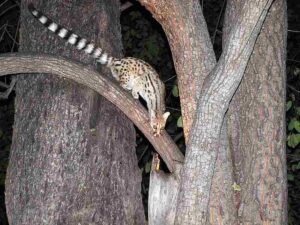
5. Eastern Chimpanzee (Pan troglodytes schweinfurthii)
Eastern chimpanzees are omnivores, consuming fruits, leaves, insects, and occasionally hunting small mammals including fellow primates like the red colobus monkey.
Also, Eastern chimpanzees influence forest dynamics by shaping the distribution of plant species through seed dispersal and selective foraging, which can have a cascading effect on the ecosystem.
These secondary consumers which have been discussed, contribute to the rainforest's biodiversity and ecological equilibrium, by influencing the populations of their prey species, aiding in seed dispersal, and maintaining the intricate web of biotic and abiotic resources in the Congo Rainforest.
4). Tertiary Consumers in the Congo Rainforest Food Chain
Tertiary consumers in the Congo Rainforest are a group of organisms that occupy the fourth trophic level in the food web and can feed on both primary and secondary consumers.
A clear sequence of energy transfer across the three consumer levels can be observed here, with tertiary consumers preying on secondary consumers, which in turn prey on primary consumers.
Tertiary consumers play an effective role in maintaining the balance of resources within the rainforest ecosystem.
Some examples of tertiary consumers in the Congo Rainforest are; Shelley's eagle owl, hippopotamus, and Congo bay owl, which function at different capacities and in different micro-niches. They are summarily discussed below;
1. Shelley's Eagle Owl (Bubo shelleyi)
Shelley's eagle owl is a high-level predator that mainly feeds on a variety of secondary consumers, which include some birds, mammals, and reptiles. They also prey on primary consumers like herbivorous rodents.
In terms of their ecologic function, these owls help to control the populations of their prey species, thereby influencing the structure of the rainforest's bird and mammal populations.
2. Hippopotamus (Hippopotamus amphibius)
While hippos are herbivores, primarily feeding on aquatic plants, they can also consume grasses on land.
Hippos have a unique role to play in the recycling of nutrients in rivers and other aquatic ecosystems within the rainforest. They also help define plant communities by influencing the distribution of aquatic plants and maintaining water holes and pathways.
3. Congo Bay Owl (Phodilus prigoginei)
The diet of the Congo bay owl is dominated by rodents, insects, and small birds.
As a tertiary consumer, these owls help to control the populations of their prey species, particularly the rodents, and contribute to the regulation of bird and insect populations in the rainforest.
Tertiary consumers are integral to the intricate network of organic life in the Congo Rainforest, as they help to maintain the balance of predator-prey relationships, thereby influencing the diversity and abundance of various species in the ecosystem.
5). Quaternary Consumers in the Congo Rainforest Food Chain
Quaternary consumers in the Congo Rainforest are organisms that occupy the fifth trophic level in the food chain, and can feed on tertiary consumers, which, in turn, feed on secondary consumers and primary consumers.
These top predators are critical tools for regulating the populations of other species and maintaining the balance of the ecosystem.
Some examples of quaternary consumers in the Congo Rainforest are; African leopard, Congo dwarf crocodile, African crowned eagle, and Nile crocodile. They are each briefly discussed below;
1. African Leopard (Panthera pardus)
In terms of their diet, African leopards are apex predators that primarily prey on a wide range of species, including various mammals, birds, and occasionally reptiles.
These powerful big cats are vital for controlling the populations of their prey, influencing the structure and distribution of mammal and bird species in the rainforest.
2. Congo Dwarf Crocodile (Osteolaemus tetraspis)
The Congo dwarf crocodile is a relatively small crocodilian, that mainly consumes fish, amphibians, and small mammals.
Congo dwarf crocodiles are apex predators in aquatic ecosystems within the rainforest, regulating fish and amphibian populations and contributing to the maintenance, of the health of waterways.
3. African Crowned Eagle (Stephanoaetus coronatus)
African crowned eagles are large raptors that prey on a variety of animals, including birds, reptiles, and mammals like rodents and monkeys.
These eagles function as apex predators in the canopy of the rainforest, affecting bird and mammal populations and contributing to the complex predator-prey relationships.
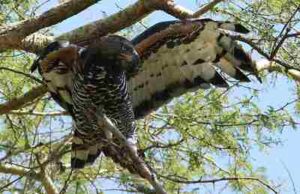
4. Nile Crocodile (Crocodylus niloticus)
Nile crocodiles are opportunistic predators that feed on a wide range of prey, including fish, other reptiles, mammals, and birds.
They are larger than the Congo dwarf crocodile, and are top predators in aquatic environments such as rivers and swamps, where they influence the distribution and abundance of various species.
Quaternary consumers are essential for maintaining the intricate balance of predator-prey relationships in the Congo Rainforest. They help to regulate the populations of other species, contributing to the overall productivity and diversity of life in this complex ecosystem.
6). Decomposers in the Congo Rainforest
Decomposers in the Congo Rainforest have a central role to play in breaking down organic waste materials, and recycling nutrients from such materials back into the ecosystem. They are responsible for the biodegradation of plant and animal remains; a process which helps to maintain soil health and nutrient cycling.
Some examples of decomposers in the Congo Rainforest are; bacteria, fungi, macroscopic saprophytes like mushrooms, as well as detritivores like earthworms, giant African millipedes, and termites. Each group/organism is further discussed as follows;
1. Bacteria
Bacteria are microscopic organisms whose primary function is the breaking down of organic matter into simpler compounds through the process of decomposition. They have a fundamental role to play in the initial stages of decay.
These microbes are essential for the recycling of nutrients in the rainforest, which makes them (that is; the nutrients) available to plants for growth and maintaining soil health.
2. Fungi
Fungi, including various species of molds, can be described as key decomposers in the rainforest. They break down complex organic compounds into simpler substances.
Through their activities, fungi contribute to the decomposition process, helping to release nutrients from dead organic material, which can be taken up by plants.
3. Macroscopic Mushrooms
Larger mushrooms also serve as decomposers, breaking down dead organic matter. They are more visible than microscopic fungi.
Macroscopic mushrooms are important because they contribute to the breakdown of larger organic materials and provide a food source for some animals in the rainforest.
4. Detritivores (Earthworms, Giant African Millipedes, Termites)
Detritivores are organisms that survive by feeding on decaying plant and animal matter. Earthworms, millipedes, and termites are examples of these organisms in the rainforest.
Detritivores break down organic substrates which they feed on, and aid in the decomposition process. Termites, for example, are known for breaking down dead wood in the rainforest.
These decomposers collectively help to recycle essential nutrients like carbon, nitrogen, and phosphorus, ensuring the rainforest remains fertile and supporting the growth of plants. Without them, organic waste materials would accumulate, and the nutrient cycle would be disrupted, which would affect the overall productivity and vitality of the ecosystem.
-Congo Rainforest Food Web
The Congo Rainforest food wen is a highly complex ecological network that comprises of multiple organisms in different trophic levels, which are interdependent on each other for survival in their habitat.
Although this model is much different from the simplistic and idealized food chain, it can be understood by analyzing multiple chain structures to find linkages and repetitive patterns among them.
Here, four Congo Rainforest food chains are analyzed briefly, as a means of understanding the structure, composition and dynamics of the food web;
1). Food Chain 1: as a Conceptual Component of the Congo Rainforest Food Web
Food chains illustrate the flow of energy through different trophic levels in an ecosystem. In the Congo Rainforest, the following food chain demonstrates the transfer of energy from one trophic level to another;
Food Chain 1: Ebony fruit, Cinchona, understory shrubs (Trophic level 1) → African Forest Elephant, Red Colobus Monkey, Okapi, African Forest Buffalo (Trophic level 2) → Eastern Chimpanzee (Trophic level 3) → African Leopard (Trophic level 4)
*Trophic Level 1 (Producers)
Ebony fruit, Cinchona, and understory shrubs are primary producers. They harness energy from the sun through photosynthesis to produce organic compounds, making them the foundational source of energy in the food chain.
*Trophic Level 2 (Primary Consumers)
African Forest Elephant, Red Colobus Monkey, Okapi, and African Forest Buffalo are primary consumers. They feed on the producers, consuming the energy stored in these plant materials. This trophic level represents herbivores.
*Trophic Level 3 (Secondary Consumers)
Eastern Chimpanzee is a secondary consumer. Chimpanzees are omnivores, feeding on a variety of foods, including fruits, leaves, insects, and sometimes small animals. In this food chain, they consume primary consumers like the red colobus monkey, as well as plant materials, thereby transferring the energy up the trophic hierarchy.
*Trophic Level 4 (Tertiary Consumers)
African Leopard is a tertiary consumer. Leopards are carnivores, which prey on animals lower in the food chain, such as chimpanzees or other small to medium-sized mammals. They represent the apex predators in this ecosystem.
Energy Transfer
Energy is transferred from one trophic level to the next along this food chain. Initially, energy from sunlight is captured by the plants at Trophic Level 1. Herbivores at Trophic Level 2 gain energy by consuming these plants. The energy is then transferred to the secondary consumers (Trophic Level 3) when they feed on the primary consumers. Finally, the energy is passed to the tertiary consumers (Trophic Level 4) when they consume the secondary consumers.
Here, it is important to note that as energy moves up the trophic levels, some energy losses occur in the form of heat dissipation, through metabolic processes. Therefore, the amount of energy available at each higher trophic level is less than in the level below, resulting in a pyramid-shaped energy structure. This is a fundamental concept in ecology that helps us understand the dynamics of ecosystems and the dependencies of species on each other for survival.
Recurring Organisms
Some organisms from Food Chain 1 that also form linkages with other food chains are;
Ebony (also occurs in Food Chain 3)
Red colobus monkey (also occurs in Food Chain 3)
Okapi (also occurs in Food Chain 4)
African forest buffalo (also occurs in Food Chain 3)
African leopard (also occurs in Food Chain 2)
2). Food Chain 2
Food Chain 2 in the Congo Rainforest represents various organisms in different trophic levels, and the flow of energy through the ecosystem. Here we discuss this food chain and highlight potential organic recurrences.
Food Chain 2: African Mahogany, Iroko, Cola tree (Trophic level 1) → African Pygmy Squirrel, Bonobo, Locust, Ants, Black Colobus Monkey (Trophic level 2) → Shelley's Eagle-Owl, African Clawed Frog, Western Lowland Gorilla (Trophic level 3) → African Crowned Eagle, African Leopard (Trophic level 4)
*Trophic Level 1 (Producers)
African Mahogany, Iroko, and Cola tree serve as primary producers in this food chain. They convert sunlight into organic matter through photosynthesis.
*Trophic Level 2 (Primary Consumers)
African Pygmy Squirrel, Bonobo, Locust, Ants, and Black Colobus Monkey are primary consumers. They feed on the plants and gather energy from the producers. This level represents herbivores and some omnivores.
*Trophic Level 3 (Secondary Consumers)
Shelley's Eagle-Owl, African Clawed Frog, and Western Lowland Gorilla are secondary consumers. They consume organisms from Trophic Level 2. Bonobos and Black Colobus Monkeys are part of their diet.
*Trophic Level 4 (Tertiary Consumers)
African Crowned Eagle and African Leopard are tertiary consumers. They are at the top of this food chain, preying on organisms from the lower trophic levels.
Recurring Organisms and Food Web Formation
The recurrence of certain organisms, in multiple food chains and trophic levels highlights their ecological importance in the Congo Rainforest's food web. These organisms serve as critical links connecting different "chains" to create the intricate network known as a food web.
Below is a list of organisms in Food Chain 2 which also occur in other food chains discussed in this article;
African Mahogany (also occurs in Food Chain 3)
Cola tree (also occurs in Food Chain 4)
African pygmy squirrel (also occurs in Food Chain 3)
Locust (also occurs in Food Chain 4)
Bonobo (also occurs in Food Chain 4)
African clawed frog (also occurs in Food Chain 4)
African leopard (also occurs in Food Chain 1)
3). Food Chain 3: as a Conceptual Component of the Congo Rainforest Food Web
Food Chain 3 in the Congo Rainforest illustrates the flow of energy through different trophic levels, with some recurring organisms. This food chain is discussed below, along with a highlight of its recurring organisms;
Food Chain 3: Ebony fruit, ferns, African Mahogany (Trophic level 1) → Mouse deer, African forest buffalo, African pygmy squirrel, red colobus monkey (Trophic level 2) → African palm civet, Congo Bay owl (Trophic level 3) → Hippopotamus (Trophic level 4) → Congo dwarf crocodile (Trophic level 5)
*Trophic Level 1 (Producers)
Ebony fruit, ferns, and African Mahogany are primary producers. They use sunlight to create organic matter through photosynthesis.
*Trophic Level 2 (Primary Consumers)
Mouse deer, African forest buffalo, African pygmy squirrel, and red colobus monkey are primary consumers. They feed on plants and the fruits from Trophic Level 1.
*Trophic Level 3 (Secondary Consumers)
African palm civet and Congo Bay owl are secondary consumers. They consume organisms from Trophic Level 2. For instance, the African palm civet may feed on small mammals like the African pygmy squirrel, which is also suitable prey for the Congo Bay owl.
The recurring organisms here are the red colobus monkey and African pygmy squirrel, which were mentioned in Food Chain 1 and Food Chain 2 respectively.
*Trophic Level 4 (Tertiary Consumers)
Hippopotamus, a large herbivore, occupies this trophic level. It feeds on aquatic plants and vegetation in the rainforest and nearby water sources.
*Trophic Level 5 (Quaternary Consumers)
The Congo dwarf crocodile, a quaternary consumer, preys on other organisms, possibly including fish and smaller reptiles in the aquatic ecosystem of the rainforest.
Recurring Organisms and Food Web Formation
The recurrence of organisms such as the red colobus monkey and African pygmy squirrel, which are also operating in other food chains, is significant in building the food web of the Congo Rainforest.
In this context, the red colobus monkey and African pygmy squirrel, both primary consumers, maintain a crucial role in channeling energy from the primary producers (Trophic Level 1) to higher trophic levels (Trophic Levels 3 and beyond). Their recurrence serves as the basis of interconnectivity from one linear sequence to another, which in turn is the principle on which the Congo Rainforest food web is built.
As the food web is continuously modified through trophic linkages, the presence of these recurring organisms helps to form the complex and dynamic structure of the rainforest's food chains by facilitating energy transfer between trophic levels.
4). Food Chain 4
Food Chain 4 in the Congo Rainforest outlines the flow of energy among various trophic levels. Let's discuss this food chain and identify any recurring organisms:
Food Chain 4: Ferns, mosses, Cola tree (Trophic level 1) → Bamboo rat, locust, bonobo, okapi (Trophic level 2) → Genet, African clawed frog (Trophic level 3) → Central African rock python (Trophic level 4)
*Trophic Level 1 (Producers)
Ferns, mosses, and the Cola tree are primary producers in the rainforest, harnessing light energy from solar radiation to convert inorganic materials like carbon dioxide and water, into organic matter.
*Trophic Level 2 (Primary Consumers)
Bamboo rat, locust, bonobo, and okapi are all primary consumers. They feed on plant materials and fruits from Trophic Level 1.
*Trophic Level 3 (Secondary Consumers)
Genet and African clawed frog are secondary consumers. The genet might consume smaller mammals, insects, or birds, while the African clawed frog primarily feeds on insects and other aquatic organisms.
*Trophic Level 4 (Tertiary Consumers)
The Central African rock python, a tertiary consumer, preys on animals from Trophic Level 3. Through the mechanism of constriction, this reptile can feed on a variety of organisms, including large mammals and birds.
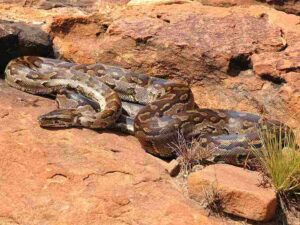
Recurring Organisms and Food Web Formation
Organisms in chain 4 that also occur in preceding food chins are listed below, with their alternate locations of occurrence in brackets;
Cola tree (also occurs in Food Chain 2)
Locust (also occurs in Food Chain 2)
Bonobo (also occurs in Food Chain 2)
Okapi (also occurs in Food Chain 1)
African clawed frog (also occurs in Food Chain 2)
Conclusion
The Congo Rainforest food chain comprises of;
Producers
Primary Consumers
Secondary Consumers
Tertiary Consumers
Quaternary Consumers
Decomposers
The Congo Rainforest food web can be dissembled into hypothetical food chains, which contain organisms that link outward from one chain to another, to ultimately produce the intricate food web structure.
Examples of such hypothetical chains are;
Food Chain 1: Ebony fruit, cinchona, understory shrubs (Trophic level 1) → African forest elephant, red colobus monkey, okapi, African forest buffalo (Trophic level 2) → Eastern chimpanzee (Trophic level 3) → African leopard (Trophic level 4)
Food Chain 2: African mahogany, iroko, cola tree (Trophic level 1) → African pygmy squirrel, bonobo, locust, ants, black colobus monkey (Trophic level 2) → shelley's eagle-owl, African clawed frog, Western lowland gorilla (Trophic level 3) → African crowned eagle, African leopard (Trophic level 4)
Food Chain 3: Ebony fruit, ferns, African mahogany (Trophic level 1) → mouse deer, African forest buffalo, African pygmy squirrel, red colobus monkey (Trophic level 2) → African palm civet, Congo Bay owl (Trophic level 3) → hippopotamus (Trophic level 4) → Congo dwarf crocodile (Trophic level 5)
Food Chain 4: Ferns, mosses, cola tree (Trophic level 1) → bamboo rat, locust, bonobo, okapi (Trophic level 2) → genet, African clawed frog (Trophic level 3) → Central African rock python (Trophic level 4)


